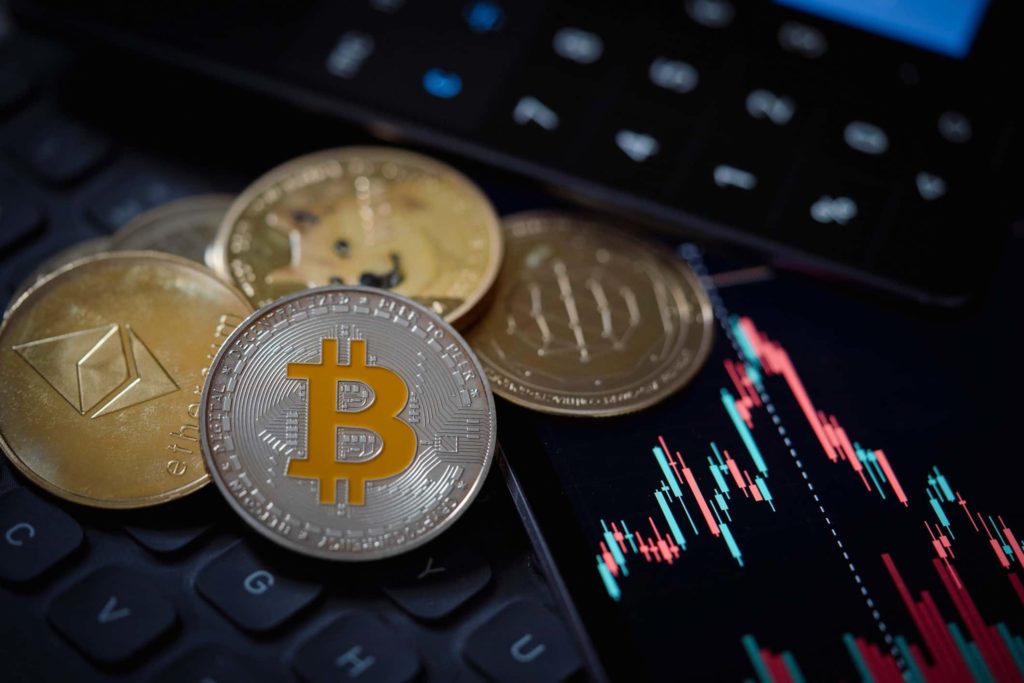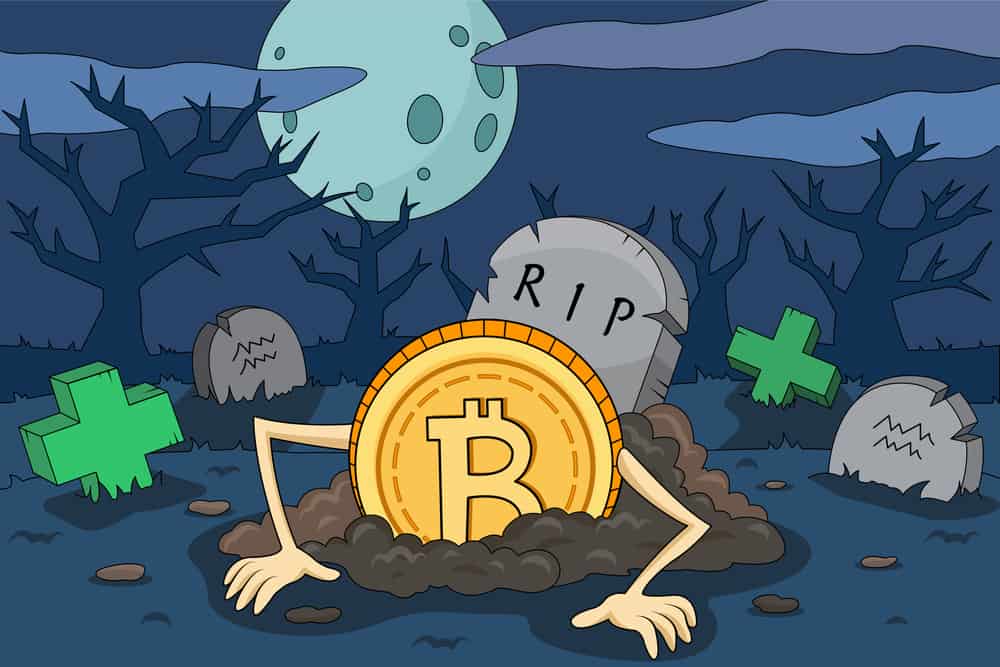
The cryptocurrency revolution, starting with Bitcoin (BTC) some 13 years ago, has grabbed the investment establishment’s and the investing public’s attention. Government officials and regulators may not be as supportive as they could be, but there is great concern that this new investment medium has been allowed to spread its wings without too many restrictive covenants. Thousands of cryptocurrencies have been launched, but only a small percentage have proven successful.
When the better ones fail, they can be classified in metaphorical terms as zombies, forever on the blockchain and never to disappear, but always a reminder of what could have been or what failed miserably for all involved. If these walking zombie crypto tokens maintain some semblance of life, there may still be a modicum of trading activity on a selective group of exchanges, but if trading transactions cease, then these crypto casualties are labelled as dead coins with no hint of life.
Observers, who are acquainted with the history of Bitcoin and the avalanche of suitors chasing crypto Nirvana, have witnessed the severe ups and downs in this industry of highly volatile assets. When Bitcoin soars, as it did initially in 2017, a multitude of new token programs enter the fold immediately with investors eager to reap the advantages of blockchain technology before their eyes. When Bitcoin values plummeted, the carnage among alternative tokens or alt-coins, as they became known, was enormous.
Since there was very little if any regulatory oversight of this crypto free-for-all, bad actors and organized crime appeared to be having a field day at the expense of exchange operators and their clients, retail and professional investors alike. Without adequate product and risk disclosures, anyone with a clever idea and a talent for marketing could launch a coin program overnight and raise millions in capital through an unregulated Initial Coin Offering (ICO).
When the crazy crypto train hit a brick wall in 2018, Crypto Winter set in, destroying the value of all programs including Bitcoin. BTC was large enough to survive and see another day, but many start-ups were not so lucky. Many alt-coins lost from 90% to 100% of their value over the next year. Liquidity was a major issue, shutting down many doors in the process, while fraud, scams, executive mismanagement, and professional hackers slaughtered the rest.
The blockchain, however, has the memory that far surpasses any elephant on the planet. Every transaction is recorded and maintained for posterity. Although a program may have closed its door, gone bankrupt, or forked in a new direction, the history of its transactions is here to stay. Zombie programs have been linked to walking about with no direction, until a new group tries to resurrect the beast. Coins may have lost over 95% of their value from their All-Time-Highs (ATHs), but trading still trickles along, waiting for better times to come.
Bitcoin has achieved two other major peaks in its timeline: just under $60,000 in April 2021 and just over $67,500 in November 2021. It subsequently crashed during 2022, resting now on soft support at roughly $16,700. Data aggregation companies like CoinMarketCap, CoinGecko, and Statista try to keep track of listed, active, and failed token enterprises. Over 22,000 programs have been registered, and less than half are active. When Bitcoin peaked, over 8,000 new entrants emerged. When BTC cratered, over 40% of these became deactivated.
Why do investors remain involved in such high-risk chaos? Greed may be part of the answer, but the fact remains that cryptos have created wealth beyond anyone’s expectations. When BTC hit $67,000, the entire crypto world was valued at just under $3 trillion. It may now be only $800 million, but enormous riches came quickly for many early believers. Hope springs eternal.
In the article to follow, you will learn about zombie tokens, dead coins, how to tell the difference, and how many were created after such enthusiastic launches. Turnarounds have yet to appear in measurable numbers in this industry, unlike with other investment mediums. If you wish to swim in these high-risk waters, the best advice is to avoid any programs that may bear the signature of potential zombie coins or dead tokens. The best way to achieve that goal is to choose a safe and reliable crypto broker, and we will share a list of our favourites at the end of this article.
What Makes a Crypto Coin a Zombie?
A zombie crypto coin or token is basically what is referred to in other quarters as a cold asset. There may be infrastructure still in place, and the token might not qualify as “dead” under an industry definition, but it has been put on the back burner, with little to no trading activity for months. Yahoo Finance recently noted that a report from Nomics, a crypto data provider, stated that as many as 12,100 crypto tokens had effectively ceased to trade over the past year. These programs are not categorized as dead, but it is difficult to find a pulse, as well.
How Does a Crypto Coin Become a Zombie?

A zombie token has had a difficult time. It was once the envy of a group of developers and investors, but what happened? Part of the reason is that it is far too easy to create a new token and few regulatory hurdles to overcome. When Bitcoin tides rise, there is ample liquidity searching for investment vehicles to ride the wave, but when the wave subsides, reality sets in. As some say, hype has a time limit. When values fall, investors lose interest and abandon crypto alt-coins, perhaps, to meet margin calls elsewhere. If fraud is present, all bets are off.
Zombie Coins vs Dead Coins
99bitcoins.com recently updated its list of dead crypto coins. Their figure stands at 1,719 coins and counting. This firm uses six criteria when reaching its determination of a certified death:
- No active development – No Github updates in six months
- No Twitter activity for one year
- Very low to none of trading activity
- No longer listed on CoinMarketCap, CoinGecko, or other data aggregators
- De-listed by the majority of exchanges, appearing on three or fewer
- Website no longer exists
Simply stated, a zombie coin is not dead if it does not meet one of these six metrics, but there is a wide difference between 12,100 tokens with little or no trade volume and 1,719 so-called dead programs. Zombie coins may still be in the game, so to speak, but just barely.
As an investor, how do you avoid contact with potential zombie crypto coins? The first step is to choose a safe crypto broker that only deals in safer programs with high liquidity and staying power. The 2022 downdraft has taken the good, the bad, and the ugly to the depths of despair. There is little evidence on the front end that things were going sour, but history dictates that when Bitcoin takes a fall, other more speculative assets are in jeopardy. Get out while you can!
Related Articles
Can Dead and Zombie Coins be Resurrected?
If you are an investor that prefers to invest in turnaround situations, be advised that a dead coin program has rarely, if ever, been resurrected. There have been many noteworthy attempts, some in the recent past like SQUID, Titan Finance, PulseDAO, 1Coin, and MeerKat Finance. These efforts, however, were transitory, each attempt only delaying the inevitable outcome. Breathing new life into a dead crypto cadaver appears fraught with far too many issues to ever succeed.
Safe Crypto Brokers
The wisest course of action to follow when trying to avoid falling victim to a zombie crypto coin is to start your journey with a safe, reliable, and trustworthy broker. We have invested our time in reviewing the best the industry has to offer, whether an exchange or an online broker. Each of the firms listed in the table below have established track records, respectable reputations, and the wherewithal to provide a safe and secure crypto trading experience for you:
No TopLists found.Concluding Remarks
Bitcoin and its alt-coin brethren have been with us now for over 13 years. The sheer volume of crypto programs that have been launched is staggering and can be overwhelming to a newcomer to this type of trading. Unfortunately, the vast majority of these programs rarely get out of the starting gate or, if they do, face an uncertain future due to a host of maladies, including shady business practices, fraud, hacking compromises, and pure mismanagement.
Out of 22,000 wannabes, roughly 12,000 of these programs have ceased trading or to be listed on exchanges and are, therefore, regarded as zombie or dead coins. Investor losses are enormous, yet the hope of finding the next Bitcoin or Ethereum remains eternal in the hearts of some investors. Carelessness in this arena, however, is quickly punished. If you want to swim with these sharks, choose a safe crypto broker, proceed with caution, and trade or invest capital that you can afford to lose.